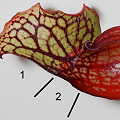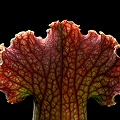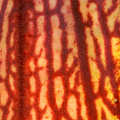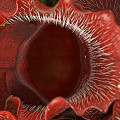Q: What are Hooker zones?

The Hooker zones

Zone 1

Zone 2

Zone 4
A: No, I am not talking about red light districts (and if you do not know what those are,
do not research them---your parents will get mad at you and we will both get blamed).
Hooker zones are named after the famous botanist Joseph Hooker, who is particularly well known for his work on
Nepenthes in the '70s--the 1870s, that is.
The zones describe the different parts of a pitcher trap, and the likely
functions of each. Hooker zones are useful not only in Sarracenia--the
traps of all pitcher plants can be interpreted using Hooker zones, even those of the carnivorous bromeliads.
The pitchers of Sarracenia have four to five Hooker zones.
Zone 1 (Attraction): This zone is the part of the plant that is dedicated mostly to attracting prey.
On Sarracenia, this is the pitcher lid. The lid has many nectar glands, and is often
brightly colored and, as in the
case of Sarracenia leucophylla, even perfumed. Insects are drawn to feed on the nectar.
Prey that forage to the underside of the lid discover that it is slick. The lids of some species are covered with
hairs that point towards the pitcher mouth, so they have a secondary function in ushering prey towards death.
Zone 2 (Conduction): This area includes the pitcher lip and extends a little way into the pitcher, and
functions to conduct prey into the pit of doom. It is characterized by bright coloration and a particularly heavy
amount of nectar secretion. Zone 2 may be a nice place to hang out and sup, but one mistake means plunging into the pit. The
conduction zone has a kind of velvety sheen to it.
Zone 3 (Glandular): This zone is deeper still in the pitcher. The walls are slick, hairless, and rich with
sunken glands that exude digestive fluid. Bugs in this zone are pretty much toast because they cannot scale the walls. Furthermore,
there probably is not enough room for them to use their wings (if they have them) to fly to freedom.
Zone 4 (Digestion/absorption): The pit at the bottom of the pitcher is flooded with fluid laced with
digestive enzymes, and hungry
commensals prowl its depths. Downward pointing hairs make it even harder to escape. The pitcher walls lack a well-developed
cuticle (the waxy layer that coats most plant parts), so nutrients can easily be absorbed by the plant. Some scientists think
this whole zone should be considered a single gigantic gland.
Zone 5 (Mystery): This final zone has no known function. In fact, I do not think it has one! I call it the
"Mystery zone." It is below Zone 4, and seems to be a resumption
of the glandular tissue characteristic of Zone 3. It is only visible in Sarracenia purpurea and
Sarracenia rosea, and even on these species is it small. In
this illustration of Sarracenia purpurea, Hooker Zone 5 is visible as
a tiny reddish portion at the base of the pitcher.
Page citations: Juniper, B.E. et al. 1989;
Rice, B.A. 2006a; Schnell D.E. 2002a.